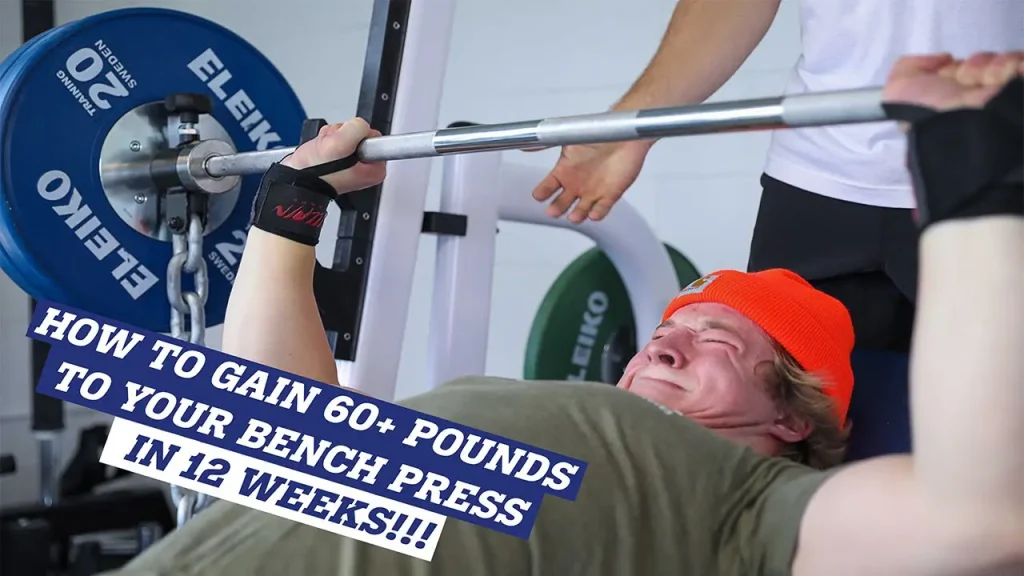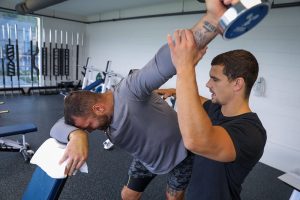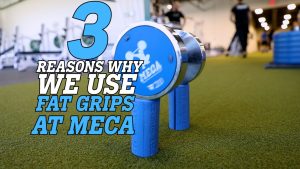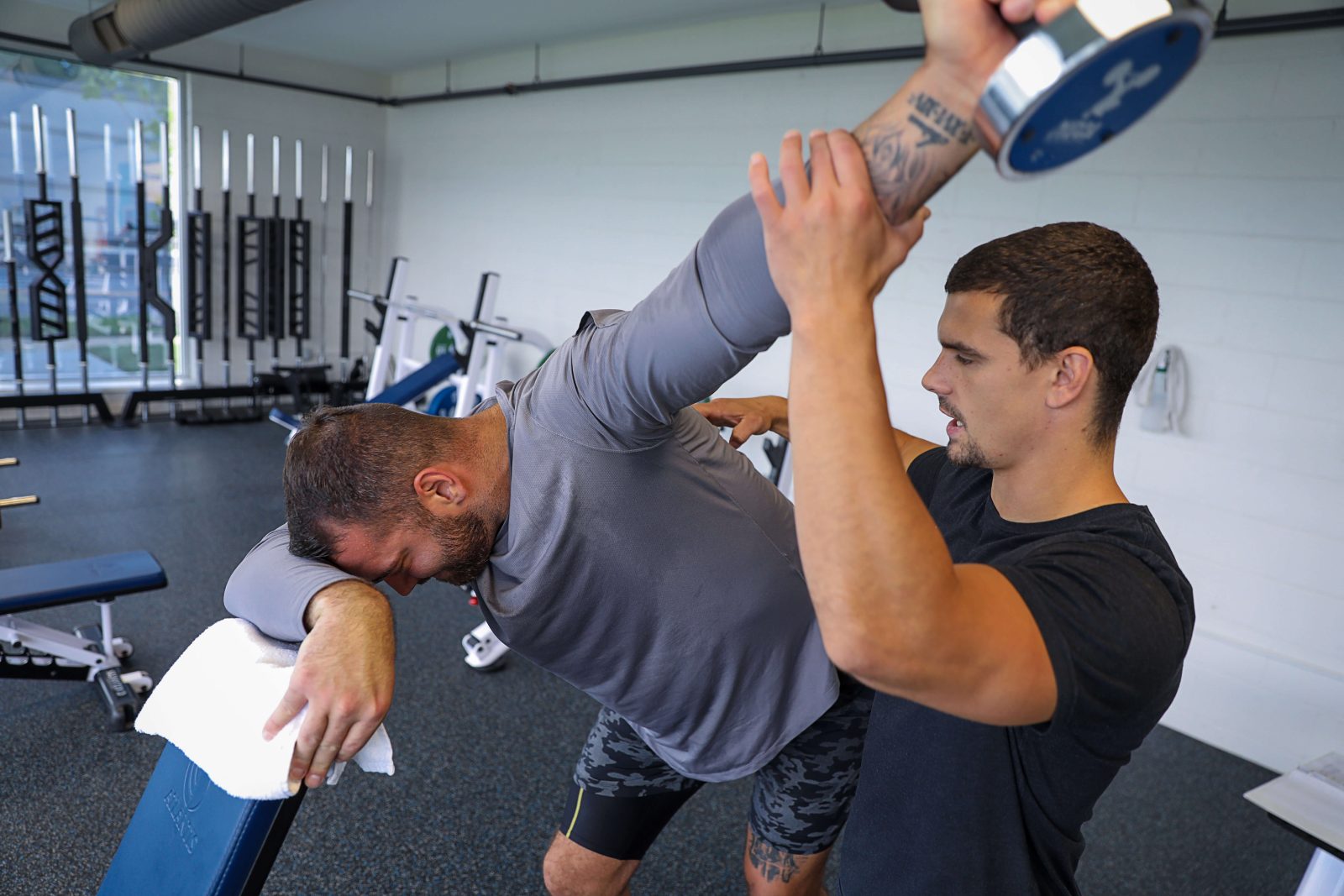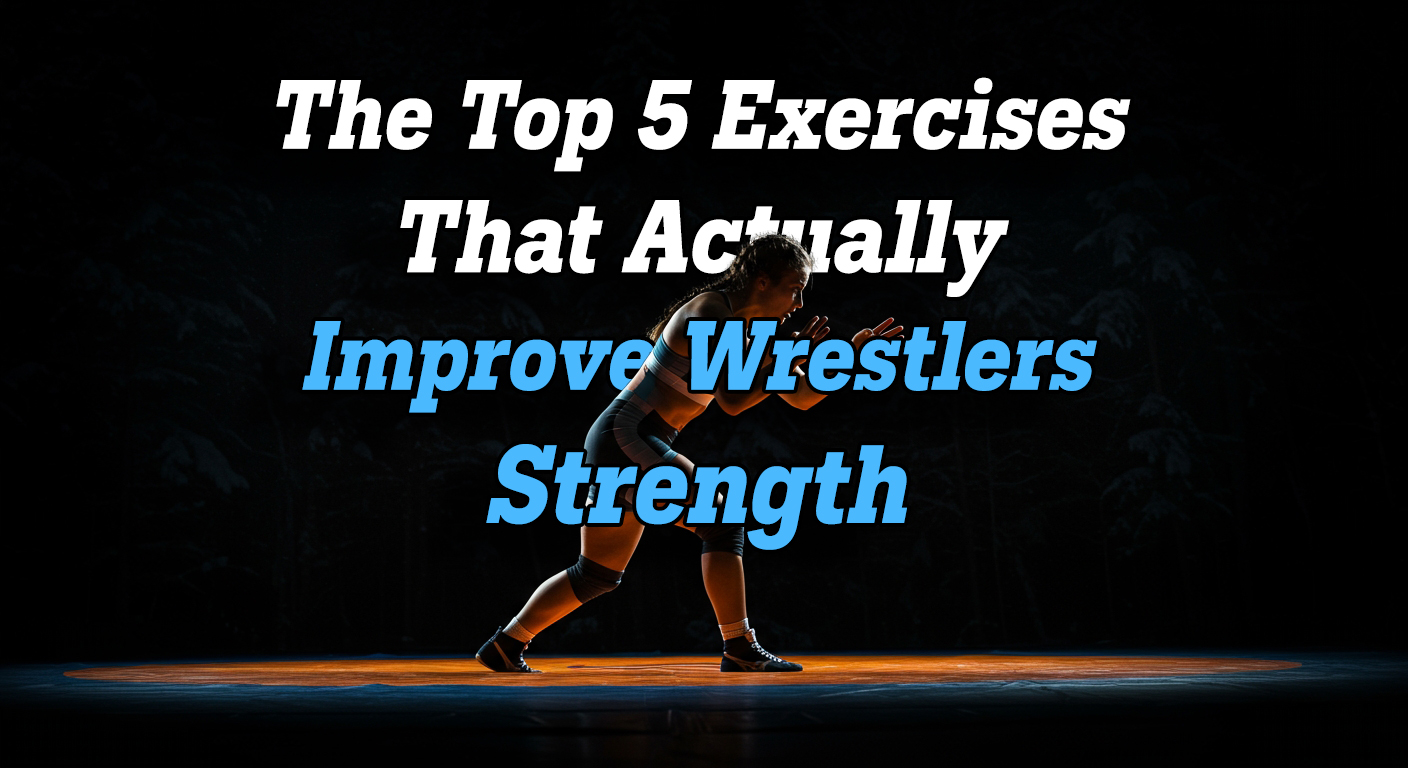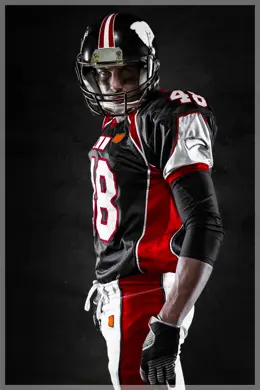Tons of fitness professionals spend time searching for the answer to the question: How to increase bench press strength?
There is a 4 step process that will ensure results and increase your bench press strength up to 60lbs! This process takes a detailed look at the muscles’ current strength levels so we can eliminate any weaknesses or pain points. Then a training program will be built to challenge the body so results don’t plateau or stagnate over time.
In this article, we will go into detail on the 4-step process that has proven to work with 1000+ athletes and how to apply it to your clients or yourself!
HOW DOES THE BENCH PRESS WORK?
The bench press is a compound upper body lift that utilizes the extensor muscle groups of the upper body. It involves you lying on your back and holding a barbell with both your hands. You then lower the bar until the bar touches your chest and press upwards until your arms are fully extended. The bench press can be performed with as little or as many repetitions as you want, but for strength, we highly recommend you stay within the 1-12 repetition range.
The bench press is probably the most popular lift in almost all training programs as it’s the best exercise to express upper body pressing power. At MECA we favor a bi-acromial close-grip bench press for all our athletes. The close grip utilizes more of the elbow joint and puts less stress on the shoulder joint compared to the standard conventional bench press or wide grip bench press.
Since the bench press is a compound lift, it utilizes multiple different muscle groups. The deltoids, the trapezius, the rotator cuffs, and the triceps are the major muscles that are involved in the movement.
THE BENEFITS OF THE BENCH PRESS
Adding the bench press into your strength program is a great way to challenge the upper body extensors. This can be very beneficial in almost all strength sports and anyone looking to put on size in the upper body.
Here is a list of benefits of the bench press:
- Increased upper body strength and power
- Increased muscle mass in the upper body
- Increased strength and power in the arms
- Increased muscle mass in the arms
WHAT ARE THE UPPER BODY EXTENSORS?
When we use the term upper body extensors, that is the term that describes the action of the muscles when they are pushing something away from the body. Pushing a bar away from your chest during the bench press primarily utilizes the extensor muscle groups of the upper body. A few of them are the pectoralis major, the pectoralis minor, deltoids, and triceps brachii. There are also many stabilizer muscles such as the rotator cuff muscles (subscapularis, teres minor, infraspinatus, and supraspinatus). The antagonist muscles, which means the muscles that oppose the action of the bench press are the latissimus dorsi, the posterior deltoid, & the biceps brachii. These muscles create the push vs pull ratio of the upper body.
INCREASING THE BENCH PRESS BY 60 lbs IN 3 MONTHS!
Adding 60 pounds to your bench press in about 12 weeks’ time is a feat only the truly dedicated and genetically gifted can do. Luckily, at MECA we have worked with thousands of athletes looking to increase their strength within a short period of time so we’ve come up with a process to systematically achieve this.
First things first, one has to work hard. You can’t make those sorts of changes by skipping workouts, not following a good nutrition plan, & not taking care of your body. Hard work is one of the biggest determinants of seeing results in the gym. This means that every training session has to count and there has to be enough work completed to create the change that the trainee is looking for.
Proper exercise technique is key to increasing bench press weight. All movements performed in the gym should be controlled, following a predetermined tempo, & completed within the joint’s full range of motion. These are key to increasing your bench press within a short period of time.
4-STEP PROCESS IN INCREASING YOUR BENCH PRESS
Our 4-step process was created to ensure results for all our clients. The process takes an objective look at your body and defines all of its strengths and weaknesses from a biomechanical point of view. We then use that data to create a training program that will balance out the affected joints in the body to create more range of motion in the joints. After structural balance is achieved, we aim to apply a different stimulus on muscles so they continue to adapt and strengthen.
With this approach, we can increase someone’s strength dramatically in a relatively short amount of time. Our training is specific to the individual in front of us and goal-orientated. So someone looking to increase the bench press movement has to undergo a physical body assessment so we can determine which type of program will be best for them.
Determining your strength ratios
- The upper body physical assessment is a 60-minute training session testing your pushing strength and your pulling strength. There are specific ratios between your pressing strength and pulling strength. Most people are stronger pushing than pulling when they start out.
- After conducting the strength tests, we then create a program based on the data collected. If someone is specifically weak in their pulling, we prescribe row variations such as single-arm DB rows and lat pull-downs. This is called structural balance training, where the weak point is targeted and strengthened. This usually lasts anywhere from 4-8 weeks and its main focus is to create balanced tension between the muscles surrounding the joints. After completing a structural balance training phase, they usually feel much better and ready for heavier weights.
Overcoming Pain
- The number one reason your bench press is not increasing is because of pain. Pain is the brain alerting you to not use a certain muscle. The pain usually is caused by underactive and/or overactive muscles or past injuries. A motor neuron communicates to the brain to fire or not fire a muscle fiber to protect the area being used. For example, if the chest muscles are overactive they are tight, the antagonist muscles or your “pulling” muscles are now underactive because they are weaker. This then sends a signal to your brain to make sure that the chest does not contract anymore to reduce the chances of tearing a muscle to further injure the area.
- If a proper structural balance assessment has been conducted, a coach would immediately know to prescribe more rowing variations in the program. This will then strengthen the muscles being pulled by the overactive pectoral muscles thus creating a balance between the two muscle groups. This will then tell the brain that it is now safe to contract the pectoral muscles because the antagonist’s muscles have been strengthened.
- When pain is eliminated and the joints are structurally balanced, strength is dramatically increased. Completing structural balance in the upper body is a surefire way to quickly increase your bench press. Most of the time, the lifts that increase your bench press are not benching-related. In fact, some clients with serious shoulder imbalances may not even press for the first 4 weeks of training!
Changing the Stimulus for bench pressing
- After about 4-6 weeks of training on a phase, you will need to change the program. We do this because around this time strength gains begin to plateau and the program becomes redundant. When the program changes, the sets and reps change as well as the complexity of the movements. This results in a different stimulus being exposed to the body.
- For example, in phase 1 you can focus on a barbell bench press with 4×8 repetitions, and in phase 2 you can focus on a close grip incline bench press for 5×3-5 repetitions. Similar movements, but the weight will be increased, the variation will be more challenging, and the muscles targeted will be slightly different.
- A lack of variety in a program can result in overuse injuries. Working the same muscle groups in specific movements can create muscle imbalances in other areas of the body, as well. Prioritizing flat pressing and neglecting your overpress can cause an imbalance between your shoulders and chest creating pain in the shoulder joint. This is why a balanced strength training program is essential.
- A strong overhead press equates to a strong bench press. Some lifts that will increase your bench press will also focus on building stronger shoulders, such as DB external rotation and Lower Trap 3 raises. These are areas that are often neglected and are the cause of a lot of shoulder pain.
- Other exercises you should add:
- Neck extension lifts
- DB single-arm rows
- External rotation
- Trap 3 raises
- Lying abduction
- Chin Up
- Seated DB shoulder press
- As you can see, most of these lifts are focused on the upper back, shoulder, and rotator cuff muscles. A strong upper back yields a stronger bench.
Using different training systems
- Using the methodology of changing your programs every few weeks, you also need to change your training system. A training system is a style of training designed to elicit a specific outcome. Different systems utilize different strength qualities.
- At first, one may need to build structural balance and increase the range of motion in the shoulder joint. After progressing for some time, that individual may need to move into a more challenging system to gain muscle. To gain strength, they may need another training system.
- Training systems are very individualistic and depend on how a trainee progresses with weight training. After a trainee builds structural balance and enough muscle tissue, a new training system can be introduced to build the bench press. Ingraining the motor pattern and utilizing different rep schemes over the course of a training cycle will lead to greater gains in the bench press.
OPTIMIZE YOUR NUTRITION FOR GREATER STRENGTH
In order to increase strength in the bench press, you need to gain muscle. To gain muscle, you will need to follow a nutrition plan. The more muscle an individual has, the more contractile fibers they can use to produce force. Someone weighing about 160 at 16% body fat will have a harder time benching 225 lbs than someone weighing 195 lbs at 9% body fat. It is basic physics.
Following a plan to create an optimal environment to grow lean muscle mass will be key. Prioritizing protein intake and pre, intra, & post workout supplementation will be the fastest way to gain muscle.
The healthier a trainee is, the more results they can achieve and the higher the output they will have in their performance. Some great supplements are our MECA foundation level supplements to gain size:
These supplements can be purchased at MECA online store. Follow the instructions on the bottle and use them to get the most out of your strength training session.
These will provide you with the full spectrum of amino acids so you can optimize your training to build muscle and recover. These supplements are taken pre, intra, and post-workout. Athletes that take these supplements will on average gain 30 to 40% more muscle than athletes who don’t take them. That could be the difference of 6-8 pounds of lean muscle.
CONCLUSION
To increase your bench press, you need to take an objective look at the weaknesses in your upper body. You then need to fix those weaknesses to overcome pain-free and balanced strength ratios between the agonists, antagonists, & stabilizer muscles. Once the body is balanced, the program must become more challenging and complex to continue to drive adaptations in strength and hypertrophy. If you are interested in progressing your bench press, check out the coaches at MECA if you want to optimize your training to achieve a stronger bench press. We also have online training programs and coaching as well if you do not live in the area! Check out our website.
FAQ’S
Can push-ups increase bench press?
- Short answer, no. The long answer is if you are really weak and never performed basic upper strength training. A push will give you a basic adaptation. If you actually want to bench a decent weight, you would need to take a structured strength training approach in order to build strength for the long term.
What are the most common mistakes in the bench press?
- Benching in every upper body workout! Too many times, trainees bench in all of their upper body workouts and end up getting overuse injuries such as shoulder impingements. A good training plan will change pressing variations and angles to avoid those errors. Any pain will stall all progress to strength.
How can powerlifting help increase bench press?
- Powerlifting is a sport dedicated to increasing the poundages to the bench press, squat, & deadlift. That is it. Powerlifters spend most of their time in the gym focusing on those 3 lifts only. If you are dedicated to those movements alone, then this could be a good option. But for athletic performance, this may not be a great option as powerlifting focuses on absolute strength and may end up making you slower.
Why is my bench press not increasing?
- Your bench press is not increasing because your strength ratios are off. Focus on a new lift instead of a bench press for 4-6 weeks. Try progression Overhead squat or dip.
How many reps increase bench press?
- To increase strength you would want to train within the 1-5 rep range. But you’d want to undulate from high rep to low rep. A good protocol would be 3×10-12 for 3 weeks, 4×4-6, 4×8-10, then 5×3-5.

